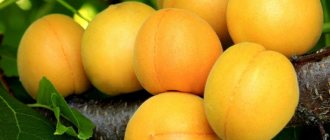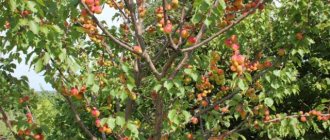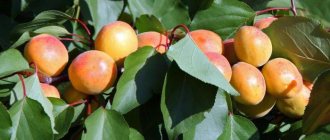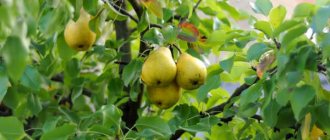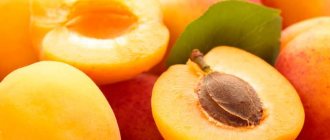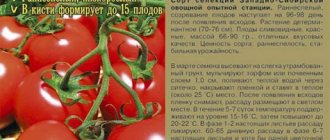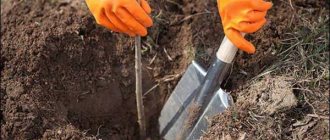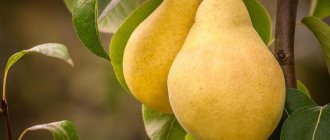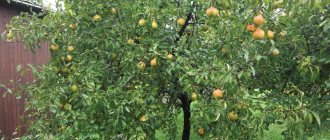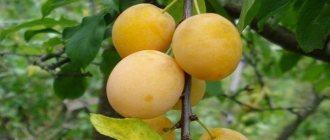Gardeners like the Manchurian variety of apricot. These are unpretentious plants, characterized by low maintenance, resistance to frost and drought. The article describes step-by-step recommendations for planting a seedling in the ground, and also provides instructions for caring for the plant, which will ensure its good growth and development.
Manchurian apricot variety
by caring for the Manchurian variety you can get a bountiful harvest
apricot variety "Manchurian" tolerates drought and low temperatures well
Description of Manchurian apricot
Manchurian apricot belongs to the Plum family. This is a tall tree that can grow up to 15 meters in height. The plant has filigree foliage and a lush crown; it throws out many shoots. The bark has a dark gray tint and cracks in deep furrows. During flowering, pink flowers appear, more than 2 cm in size, growing singly or in groups on the branches, the stalks are short. There is abundant flowering every spring from April-May.
The leaves are characterized by a broadly oval, double-serrate shape, have pointed tips, their size reaches up to 12 cm. The fruits are medium-sized, about 2.5 cm in diameter, the peel is yellowish-orange.
A fruit seed easily grows into a tree that can live for more than a hundred years.
Apricot "Manchurian": yield
On structured, fertile soil, the Manchurian apricot will grow and bear fruit just perfectly, although even on rocky soil the shrub will give a good harvest. After planting, trees of this variety will begin to bear fruit in 5-7 years. Productivity will be annual, high and stable, without jumps. About 40 kg of fragrant fruits are harvested from a single bush. If you follow the standards of care and other gardening measures, it is quite possible to increase the amount of harvest to 50 kg from each tree.
Apricot Manchurian: application
The originality of the taste of the Manchurian apricot variety is caused by the decorative component of the variety, but noticeable sourness and slight astringency have little effect on the standard use of the fruit: preserves, jams, compotes, fresh consumption. Even apricot kernels have found wide application: - in cooking they are used fried to replace almonds, - in cosmetology - in the production of oil saturated with healthy fats.
Pests and diseases
The most dangerous for the Manchurian apricot variety are spider mites, aphids and cherry borer. To scare them away and stop their spread, it is enough to use products that are sold in specialized stores. The diseases that most often affect the variety are verticellosis and blight.
Characteristics of the variety
The Manchurian variety, which was used by I.V. Michurin as a rootstock for experiments, has striking differences in comparison with the species of the same name. Below are detailed characteristics of the variety.
Drought resistance and winter hardiness
This variety can easily withstand severe frosts down to -30 degrees, thanks to its strong bark. An adult plant has a higher resistance to drought than a young tree. Every year, the roots of the plant penetrate deeper into the soil, independently obtaining the moisture that a large tree needs.
Young trees should be watered regularly during dry weather.
Pollination, flowering period and ripening time
Flowering lasts for 12 days. In some regions it begins in early April. In the northern regions, flowering occurs during the thaw period. The flowers are characterized by a colorful aroma, which is why they are especially attractive to wasps and bees, the pollinators of this variety.
Productivity and fruiting
At the beginning of June, the Manchurian variety tree pleases gardeners with ripe but small fruits. Despite the fact that apricots are small, the yield is quite high. From one mature tree it is possible to harvest about 250 kg of apricot. Fruiting begins in the 5th year after planting the seedling on the site.
Area of application of fruits
Apricots of this variety have a specific taste, this is due to its decorative purpose. The fruits are characterized by a peculiar acidity and minimal bitterness, but this does not have any effect on the universal use of the fruit. Apricots can be consumed fresh and used for making compotes, jams and preserves.
Experienced chefs have gotten used to using even apricot kernels: they are fried and the taste turns out to be almond-like. It is also possible to prepare delicious apricot oil from the seeds, which turns out to be very fatty - the product is actively used in cosmetology.
Resistance to diseases and pests
This variety is a winter-hardy plant with increased resistance to fungal and viral infections. Insects are considered the main enemies of the Manchurian apricot, but they are easy to combat by spraying.
Advantages and disadvantages
Manchurian apricot has many advantages and virtually no disadvantages. The positive qualities of this variety include the following:
- High yield. As they grow older, the number of fruits collected from one tree does not decrease.
- Decorativeness of the bush. During flowering, this plant becomes a real decoration of the garden.
- Good transportability. The fruits are characterized by resistance to mechanical damage and can easily withstand long-distance travel without losing their appearance and taste.
- High immunity. The main feature of this variety is resistance to diseases and pests.
- High shelf life. Apricots can be stored for a long time, this will not affect their appearance in any way.
- Resistance to climate change. The plant withstands not only drought, but also severe frosts.
The disadvantages of the Manchurian variety include the peculiar taste of the fruit, which not everyone likes.
Description and characteristics of culture
Apricot Manchurian is an ornamental tree and shrub. The height of the plants can reach 10–15 m. The crown is openwork, spreading, dense. The trunk of young specimens is light brown. With age, it becomes darker and becomes covered with deep furrows. The root system is powerful, branched, and goes deep underground. Develops throughout the entire life cycle. Previously, the crop was often used to strengthen slopes and coastlines.
Did you know? Apricot was actively used as a culinary ingredient and for cosmetic purposes to improve skin condition and rejuvenate, back in Ancient Egypt.
Decorative plants are provided by large foliage, which changes color seasonally and remains on the tree until mid-November. Leaf buds bloom after flowering. The leaf blades are oval in shape with serrated edges. They are painted bright green on the outside and dark green on the inside. As autumn approaches, they turn yellow and red. The leaves begin to fall after the arrival of frost.
Drought resistance, winter hardiness
Manchurian apricot is a heat-resistant plant. Able to grow on rocky soil, rocky cliffs in dry conditions. The plant also tolerates low temperatures well. Feels normal at -30°C.
Pollination
The culture is self-fertile. It copes well with providing pollen for itself and other varieties.
Flowering period and ripening time
Depending on climatic conditions, flowering begins in April - May. This growing phase lasts 12 days. The fruits ripen in late July - early August.
Productivity, fruiting
The crop begins to bear fruit at 4-5 years. Productivity increases over the years and can be up to 60 kg per plant. The life cycle of the apricot variety in question lasts over 100 years. Unlike many other varieties, growth and fruiting are maintained throughout the entire life cycle.
Distribution and climate features
Manchurian apricot is a rare plant listed in the Red Book. It grows in China in the northeastern provinces, northern Korea, as well as in the vast southern territory of the Primorsky Territory in Russia. This tree can tolerate both drought and low temperatures. Loves a sufficient amount of light, but is not demanding on soil: it can grow even on dry mountain slopes.
Manchurian apricot has a large and branched root system, so it is good to plant it along reservoirs to strengthen the coastline, as well as slopes to protect them from landslides.
Manchurian apricot: what is its peculiarity and how to grow it?
Gardeners like the Manchurian variety of apricot. These are unpretentious plants, characterized by low maintenance, resistance to frost and drought. The article describes step-by-step recommendations for planting a seedling in the ground, and also provides instructions for caring for the plant, which will ensure its good growth and development.
Manchurian apricot variety
by caring for the Manchurian variety you can get a bountiful harvest
apricot variety "Manchurian" tolerates drought and low temperatures well
Features of planting Manchurian apricot
Growing a plant begins with planting a seedling. If all requirements are correctly met, the plant will take root quickly, ensuring its further development and growth. Gardeners need to know about planting dates and choosing healthy seedlings.
What time should you plant?
It is best to plant an apricot seedling at the end of April. During this period, the soil is well warmed by the sun's rays. It is undesirable to delay planting; it is carried out until the fruit buds swell. It is permissible to plant the plant in the autumn, but this should be done carefully so that winter frosts do not harm the fragile plant.
Selection and preparation of a site
To plant Manchurian apricot seedlings, choose a place in a well-lit area with aerated and lime-containing soil. Make sure that there is no stagnant moisture or strong salinity in this area. The most favorable place for the Manchurian variety is an area protected from the north wind. To avoid the flow of cold air, do not choose places in the lowlands.
Creating a planting hole before planting an apricot will help ensure proper development of the tree in the future. A large depression is made for planting, since the root system needs space. The minimum parameters of the pit are 65x80 cm.
What can and cannot be planted nearby?
The best option for this variety would be adjacent to other apricots of other varieties. The Manchurian variety does not like to grow close to red rowan, walnut, cherry, plum, apple, and pear.
How to choose and prepare a seedling?
The apricot planting material purchased in the spring should be strong and look healthy. Inspect the root system; there should be no deformations on it. Seedlings 1 year old are considered suitable for planting.
Preparing a seedling involves cutting off damaged roots and existing tears. Use a sharp garden knife. It is undesirable to trim existing sections, as this may negatively affect the survival of the root system.
Avoid drying out the roots during transportation and storage before planting in a permanent area. If the seedling does dry out, water will help restore it - place the plant in water for 48 hours. A mixture of chernozem and mullein will help prevent the roots from drying out - the root system of the seedling is dipped in it.
Step-by-step instructions for planting Manchurian apricot
To properly plant a seedling, follow the instructions below:
- The day before planting, place the root in clean water.
- Make a mixture by mixing mullein with clay to a creamy consistency. Briefly place the roots in the prepared mixture.
- Dry the roots.
- Make a planting hole, deepening the soil to the size of the root system, and water.
- Place the seedling in the center of the hole and carefully straighten the root system.
- The root collar should be 5 cm above the soil surface.
- Cover the roots with soil and compact the soil thoroughly.
- Place an earthen roller along the diameter of the hole and secure the seedling to a peg.
- Water the plant with two buckets of water and level the roller.
- Mulch the tree trunk circle with a layer of peat or humus.
Apricot Manchurian: real reviews, planting tips with photos
Manchurian apricot is an ornamental shrub that is very popular due to its chic appearance, high yield and fruits of a very original taste.
History of the emergence of culture
The Manchurian apricot was developed by Chinese scientists in Russia. The researchers had a rather exciting goal: the resulting apricot should resemble sakura. Scientists were able to obtain and maintain quite satisfactory results, and already in mid-2005, the Manchurian apricot was included in the State Register of the Russian Federation.
Apricot Manchurian: variety description and characteristics
Apricot Manchurian: photo of the variety
The Manchurian apricot found its place in the Red Book due to the rarity of the species, because the variety was developed relatively recently. This shrub reproduces easily and quite simply, so gardeners on whose plots apricot grows are real lucky ones - after all, the Manchurian variety looks really impressive.
The thick, spreading crown with many shoots looks like an openwork tablecloth. The height of an adult shrub reaches 15 m, the trunk diameter is on average 40 cm. The bark of an adult plant is dark, covered with wide furrows, while that of a young plant is much lighter, light brown, the shade of milk chocolate.
Apricot leaves are oval-shaped, with a sharp tip, of average size about 11-12 cm.
The leaves range in color from bright green to dark green in summer and turn yellow with speckles and a slight reddish tint in early fall.
Because of such an original, pleasant color, the variety is quite popular among breeders who love to decorate their gardens and plots with unusual ornamental plants.
It is interesting that leaves begin to fall from the branches only with the first frosts, approximately in the second ten days of November.
During the flowering period of the Manchurian apricot tree, you can see quite large pink buds of the most delicate shade, arranged in groups or hanging alone on short stalks. During flowering, the shrub looks like a huge, magnificent flower, partly due to the fact that the leaves bloom only after the buds.
The size of the Manchurian apricot fruit reaches 2.5 cm, which is considered quite impressive, and the weight is about 20 g. The color of the fruit is yellow-orange, the aroma is honey, and they taste sweet, with a peculiar, pleasant sourness. The best places for cultivation, according to experts in the field of breeding, are the Far East and Siberia.
Apricot bushes of this variety grow and bear fruit for about 100 years, which gardeners really like. But to achieve such a long life, it is important to carefully observe the conditions of planting and care. You also need to choose the right place on the site, rather based on aesthetic considerations, since the variety is not picky about the soil and has strong, branched roots.
The Manchurian apricot variety plant perfectly adapts to sudden changes in temperature and has high endurance: it simply tolerates dry days and a significant drop in temperature. The plant is also well suited for temperatures in the north of the middle zone, as it has high winter hardiness and easily takes root in regions with a fairly cold climate.
Timing of pollination, as well as flowering and ripening
Apricot Manchurian: photo of the variety
The shrub is able to ensure pollination and even increase the productivity of other plants; it is enough to plant 3-4 shrubs of the Manchurian variety on the site.
If you don’t plan to plant so many plants, it will be enough to graft other plants on the bush.
The Manchurian apricot tree gains color at the very end of April and blooms for 12 days, and the harvest can be harvested in July.
Apricot "Manchurian": yield
On structured, fertile soil, the Manchurian apricot will grow and bear fruit just perfectly, although even on rocky soil the shrub will give a good harvest. After planting, trees of this variety will begin to bear fruit in 5-7 years.
Productivity will be annual, high and stable, without jumps. About 40 kg of fragrant fruits are harvested from a single bush.
If you follow the standards of care and other gardening measures, it is quite possible to increase the amount of harvest to 50 kg from each tree.
Apricot Manchurian: application
The originality of the taste of the Manchurian apricot variety is caused by the decorative component of the variety, but noticeable sourness and slight astringency have little effect on the standard use of the fruit: preserves, jams, compotes, fresh consumption. Even apricot kernels have found wide application: - in cooking they are used fried to replace almonds, - in cosmetology - in the production of oil saturated with healthy fats.
Pests and diseases
The most dangerous for the Manchurian apricot variety are spider mites, aphids and cherry borer. To scare them away and stop their spread, it is enough to use products that are sold in specialized stores. The diseases that most often affect the variety are verticellosis and blight.
Apricot Manchurian: pros and cons
The pronounced advantages of the Manchurian apricot variety include:
- high yield without decreasing with the age of the tree;
- ability to withstand transportation, loading and unloading;
- Manchurian apricot can be stored for a long time, without losing its visual appeal and taste;
- shrubs are resistant to sudden temperature changes;
- the variety is not susceptible to most diseases;
- decorativeness, special beauty of the crown.
The only possible disadvantage of the plant is the peculiar, very interesting taste of the fruit.
Apricot Manchurian: planting varieties
Apricot Manchurian: video about the variety
For the rapid and proper development of the crop, it is important to comply with all planting conditions, then the tree will be beautiful and the fruiting will be even and abundant.
Best disembarkation time
The most ideal time for planting is the end of April, when the soil is already slightly warmed by the spring sun. But it is important not to delay planting and do it before the buds swell. It is also possible to plant shrubs in the fall, but you should be more careful - severe winter frosts can seriously harm a fragile tree.
Drop off point
It is ideal to find a sunny place on the site with soil containing large amounts of lime, without stagnant moisture and excess salts. It is also important to protect the tree from the northern, cold wind, so apricot bushes of the Manchurian variety are usually not planted in the lowlands.
Neighborhood with other cultures
The Manchurian apricot variety is quite individual, so it tolerates proximity well to other apricot varieties, but it is better to plant the shrub from walnut, rowan, plum, cherry, pear and apple trees and keep it away.
Planting material
The pits of the Manchurian variety of apricot, even after a few years, can grow into a beautiful, strong tree, but before planting them, to be sure, they must be checked.
It is enough to put the seeds in a glass and fill it with water, and then remove the floating, unusable seeds.
It is better to store planting material in damp, well-ventilated sand at a temperature of about 0C for 3 months.
Landing sequence
The seeds are planted in a furrow at least 1 cm deep - the seeds are placed and covered with soil, and then be sure to be watered abundantly. The apricot seedling is placed in a hole fertilized with a compost mixture so that the root neck protrudes 2-3 cm.
The Manchurian apricot requires almost no special care, but it is important: - follow the watering regime, especially in the first year, you should water once every 5 days, and after a year - only when the soil dries out. If you flood the bush, the shoots of the plant will not be able to grow sufficiently and will die with the first cold weather; - annually prune damaged and withered branches.
This should be done in spring, early March, and autumn; - feed the apricot at least 2 times a year. In April-May it is better to choose mineral fertilizers, and in the fall - organic.
In summer, fertilizing is carried out only when there is a lack of nutrients; - do not forget to loosen the soil near the tree trunk and carry out mulching; — whitewash the trunk with whitewash (add copper sulfate to protect against various bugs); - insulate the trunk with a layer of mulch for the winter.
Apricot Manchurian: propagation
Reproduction is possible both by stratified seeds and green cuttings.
Propagation by seeds
The pits of ripe apricots are soaked, the best ones are selected and stored for 3 months, and then planted in the ground and watered frequently. Seedlings are planted in a permanent place only after 3 years of cultivation in a queen cell.
Propagation by cuttings
Cuttings harvested in the second summer month are planted only in mid-September.
For cuttings, choose thick branches, leave 3 internodes and several leaves, and then leave them in a warm, growth-stimulating solution (about 24 C) for 15-16 hours.
The rootstock for cuttings should be selected from a variety that is maximally accustomed to the conditions of a given region - this will ensure high yields and a long life of the tree.
Prevention and treatment of diseases
The drug “Hom” will help to cope with spotting, which should be used exactly according to the instructions. A solution of soap will help defeat verticillium, including for preventive purposes.
Ticks will evaporate after using insecticidal preparations such as "Regent", the cherry elephant is afraid of a solution of potassium permanganate, and aphids do not tolerate preparations with copper.
- Ekaterina Fedorovna, Moscow region: “I have been growing apricots on my plot for a long time, and the Manchurian variety of apricot is especially beautiful in the fall. I harvested my first harvest in the 6th year; there were a lot of apricots, as every year. In order not to reduce the yield, we plant this variety in a whole group so that it is easier to pollinate. In preparations I usually mix it with fruits of another variety, this gives it a piquancy. Be sure to turn the bones into butter or fry them. In general, Manchurian apricots provide both beauty in the garden and profit.”
- Igor Viktorovich, Amur Region: “I planted seedlings of the Manchzhursky apricot variety on my plot - I liked it for its unpretentiousness and resistance to frost. Now it’s growing, and I donate the seeds and sell the seedlings, I’m quite happy. There is always a lot of harvest, the plant itself is beautiful, and all the seedlings are working. Although the taste of the fruit is not standard, many people like it, and what is also attractive is that Manchurian apricot can be grown in cold regions.”
Source: https://ogorodnash.ru/abrikos-manchzhurskij/
Apricot care
Caring for apricots is not particularly difficult. Good plant development is ensured by following important rules:
- Watering. Carry it out in a timely manner, especially in the first year after planting. Water the plant once a week. When the plant gets stronger, you can water it only if the soil is dry. Excessive humidity can lead to the fact that many shoots will not be able to fully form before the onset of frost, which can lead to death.
- Sanitary pruning. Be sure to carry out this procedure every year. Remove dry, damaged and diseased branches and excess growth in a timely manner. Prune apricot trees in early spring and fall. Read more about when and how to prune here.
- Feeding. Feed the plant twice a year. Apply mineral compounds in the spring, and organic matter in the fall. During the summer period, nutrition can be added only if signs of deficiency of certain substances appear.
No less important procedures are loosening the circle around the trunk and mulching, as well as liming the trunks, for which they use garden whitewash with the addition of copper sulfate - it protects against pests. To insulate the trunk for the winter, the trunk is insulated with a thick layer of mulch.
Characteristics of the Manchurian apricot variety, description of frost resistance and seedling care
Thanks to the Manchurian variety, gardeners and landscape decorators have the opportunity to create a hedge that separates the garden plot from natural bodies of water. The powerful root system of the Manchurian apricot not only is not afraid of large amounts of water, it is capable of strengthening the coastline. The winter-hardy variety is a rootstock for many northern varieties of apricots.
Description of the variety
Despite all the advantages of Manchurian, I would like to start describing the variety with its decorative qualities. During flowering, the tree looks more like sakura than a traditional apricot, which was the goal of the breeders.
The crown resembles a white and pink ball, consisting of inflorescences of large white and pink buds (up to 2.5 cm in diameter). During the fruiting period, the color of the tree appears yellow due to the large number of fruits, and in the fall it turns purple.
Reddened leaves (5-12 cm in size) remain on the branches until late autumn.
Inconvenient for the gardener is the tall dark brown trunk of the tree, reaching 15 meters in height, which is not typical for varietal fruit trees.
The trunk of an adult plant is 50 cm in diameter, the bark on it is similar in characteristics to a cork tree, deep cracks are not a disease, but a feature of the species.
The endurance and strength of the root system, which extends several meters underground, suggests planting away from buildings.
Apricot Manchurian can live for more than a hundred years, all this time the root system will develop and strengthen, capable of destroying the concrete foundation.
Attention! Apricots do not tolerate proximity to currant and raspberry bushes. All other plants cannot grow next to the giant, which depletes and dehydrates the earth.
Despite these features of the root system, when transplanting, the Manchurian apricot seedling is buried so that the root collar rises 2-3 cm above the ground.
Fruit:
- oval shape;
- slightly flattened laterally;
- length 4-5 cm;
- weight 20 g;
- light orange color;
- the skin is velvety.
The tree bears fruit abundantly, but the taste of its fruit is called specific. Sweet and sour fruits are perfect for eating raw and for preparing winter preparations - compotes, jams, confitures, preserves.
Advantages and disadvantages of the variety
Unpretentiousness, ease of care, high decorative characteristics, powerful root system are the undeniable advantages of the variety.
As a rootstock, Manchurian apricot is used to improve the quality of other varieties of winter-hardy apricots.
The disadvantages include the height of the tree, which complicates harvesting and pruning the crown. The bitter taste reduces the tasting characteristics of the fruit.
Features of planting and care
To grow Manchurian apricot, fertile soil is required, but it does not matter at all whether the food source is silt, sandy loam or rocky soil. Planting for plants of this type is preferable in the spring, then the seedling grown in greenhouse conditions or in another region will have time to adapt to the climatic conditions of the area.
Standard annual care:
- If there is a long absence of rain in the summer, the tree must be watered abundantly with water warmed in the sun.
- Mulch - mown grass, straw, hay - will help retain moisture in the soil at the roots.
- Root feeding is done twice a year.
- Loosening the soil within a radius of 2-2.5 meters from the trunk.
- In spring and autumn, branches with damage, old and fast-growing ones, which take away the plant’s strength for fruiting, are removed.
- The cutting areas are treated with garden varnish.
- Whitewashing of the trunk is also carried out in autumn and spring.
Attention! When planting seedlings near water, it is necessary to create a 20 cm drainage layer of crushed stone.
Every gardener carries out the same care measures with apple, pear, cherry, plum and other fruit trees. This may seem difficult only to a novice gardener. Over time, this becomes natural and inevitable. Compliance with the treatment time against pests, fungi, and infectious diseases is the key to tree health and a high yield.
Source: https://DachaMechty.ru/abrikos/manchzhurskij.html
Tree propagation
There are several ways to propagate Manchurian apricot in your garden. To do this, use bones or cuttings from trees.
From the seed
There are some peculiarities when propagating using this method. When planting seeds in the fall, the exact germination result is unknown - it may not exist at all, or it may be possible to obtain a high rate - up to 90%. This planting material can be stored in the soil, maintaining germination for years, and can suddenly awaken at any time.
To obtain a positive result, it is recommended to plant immediately before winter, otherwise during the autumn thaw, seeds planted before this period may sprout earlier and die at the first frost.
How to carry out the procedure:
- Fill the selected seeds with water and get rid of those that float to the surface - this ensures that low-quality material is rejected.
- Then plant high-quality seeds to a depth of about 1 cm, preventing the root collar of the seedling from ending up underground and rotting.
- Before planting, carry out a three-month stratification: keep the seeds in a cold room at a temperature of about 0 degrees, after immersing them in a container with sand, without covering. This further helps ensure good germination.
After planting and germination of the seedlings, take good care of them: water, loosen the soil around, remove weeds, mulch. After two years, young seedlings can be planted in a permanent place.
By cuttings
To propagate a tree by cuttings, prepare them in late June-early July, and plant them at the end of September. Proceed as follows:
- To prepare planting material, cut a cutting from the most powerful and strong tree branches with 2-3 internodes, on which there are several leaves.
- Cut the cutting from the top perpendicular to the growth of the trunk, about 1 cm above the bud, and make a beveled cut from the bottom.
- Place the prepared cuttings in a container with a liquid growth stimulator and leave for 15 hours in a warm room at a temperature of at least 24 degrees Celsius.
Prepare the landing site in advance:
- Make a small track of the required length; its depth should be 50x90 cm.
- Place broken bricks at the bottom of the track, and on top make a layer of river sand up to 5 cm high.
- Next, lay a layer of soil mixture of sand, soil, manure and wood ash in the ratio (1: 3: 1: 1.5).
- Spread the mixture evenly over the bottom of the rut, compact and moisten with a weak solution of potassium permanganate.
Planting of seedlings should be such that the base slightly touches the layer of soil mixture at the bottom of the rut.
Types of propagation of ornamental apricot
Despite the fact that the culture is listed in the Red Book, it propagates quite easily and quickly using seeds or cuttings. The most interesting thing is that even when planting seeds, all parental qualities are completely preserved.
Seeds
If possible, you can collect the seeds yourself or order them from a nursery. They are usually packaged in 10–20 pcs. in a bag. They retain their ability to germinate for 2 years from the date of collection. Before planting, they are soaked in water for about a day. Then those that float are discarded, and those that settle to the bottom are placed in a pot with sand. The seeds are kept at a temperature of 0°C in a dark room for 3 months.
Video: How to plant Manchurian apricot from a seed
After this, they are planted in a greenhouse or in separate pots. If you use pots, it is better to immediately take self-decomposing peat ones. Sow the seeds to a depth of 1 cm. Prepare loose, nutritious soil for the seeds. To do this, mix peat, compost, and sludge in equal proportions and add 20% of the total mass of wood ash. Planting in a permanent place is carried out when the plants reach 2-3 years of age.
We advise you to read in more detail how to grow an apricot tree from a seed at home.
Cuttings
Cuttings are harvested in the spring. Select well-developed specimens with mature wood and at least 3 buds. After pruning, the cuttings are kept in the Kornevin solution (1 tsp/1 l of water) for 24 hours. Then they are moved to clean water and wait for the roots to germinate. Change the water in the vessel every 3 days, adding 0.5–1 tablet of activated carbon and 1 drop of hydrogen peroxide. When the cuttings take root, plant them in a peat pot. Already in the spring, the seedling can be planted in open ground.
Also, cuttings can be grafted onto other varieties of apricots . For this purpose, it is best to choose varieties zoned in a particular region. So, immediately after the procedure of soaking in “Kornevin”, the cuttings are not left to germinate roots in water, but are grafted onto another plant.
To do this, the end of the rootstock is made sharp. On the scion, at a height of 5–7 cm from the ground level, an incision is made in such a shape that the cut end of the cutting can fit freely into it. Then they insert the rootstock into the scion, seal everything with garden varnish, and then wrap it tightly with electrical tape. After just a month, you can carefully remove the electrical tape and check the result of the work.
Read more about how and what you can graft an apricot on.
Diseases and pests
Manchurian apricot is characterized by increased resistance to various diseases and pests. But occasionally, plants can be susceptible to diseases and insect attacks. The gardener needs to know what control measures to take:
| Disease/Pest | Signs | Treatment/Prevention |
| Hole spot | A disease in which leaves and fruits suffer - reddish-brown spots form on them, which over time turn into holes. Then the leaves begin to fall off and the fruits become deformed. | For treatment, cut off the foci of the infection carrier and burn them. Disinfect wounds and cracks with garden putty using copper or iron sulfate. For prevention in early spring and autumn, spray the plant with 5% Bordeaux mixture, after flowering - 1%. |
| Verticillium | A harmful and insidious fungal disease that can be fatal. It manifests itself as rotting leaves from below. | The fight is based on early treatment. The best drugs for treating the plant are Vitaros, Fundazol, Previkur, etc. |
| Spider mite | A pest that settles on the underside of leaves. It multiplies quickly. Mites quickly suck the juices out of the leaves, causing them to turn brown, dry out, and then fall off. This leads to weakening of the entire plant. | To combat ticks, spray the plant with special anti-tick preparations - acaricides. |
| Cherry elephant | This is a small purple bug that feeds on apricot buds, buds, flowers and ovaries. May also harm fruits. | Treatment consists of shaking the tree and destroying fallen pests. If there are a lot of bugs, it is recommended to spray the plant with a solution of karbofos or the drug Inta-Vir. |
| Aphid | This is a pest that bites through tissue and sucks juice from young leaves. This leads to deformation of the leaves and shoots, and eventually they dry out. | Insecticides are used to control aphids. The best drugs are considered to be Fitoverm and Fufanon. |
Characteristics of the fruit crop
Manchurian apricot is an unpretentious tree.
Drought resistance, winter hardiness
The development of a powerful root system provides the plant with moisture from a large area and depth. Thanks to it, apricot can withstand long periods without precipitation. But this must take at least 5 years. Until this time, young trees may suffer from drought.
Manchurian apricot can withstand 30-degree winter frosts without wind. Early thaws cause damage to flower buds and reduced yields.
Immunity to diseases and pests
A healthy tree is rarely affected by pests, with the exception of aphids, which attack apricots in June if the weather is hot. Favorable conditions for the appearance of a fungal infection occur during the flowering period. In April-May, cold temperatures down to +5 degrees with rain and wind are not uncommon, awakening fungal spores. Without timely control, the degree of damage to the bark and flowers will increase.
Harvest time and storage conditions
The ripening period of apricots depends on the growing region. The Manchurian variety begins to ripen at the end of July. If storage conditions are observed, it will be possible to preserve the apricot harvest for a long time. At a temperature of 20-23 degrees, fully ripe fruits are stored for several days. If the harvested fruits are not fully ripe, they will fully ripen in 2-3 days and be suitable for consumption.
Storing large quantities of crops will be optimal in a cool room with an air temperature of 10-15 degrees and a humidity of 50-70%. It is recommended to wrap the fruits in parchment and carefully place them in wooden boxes. This way they can be stored for 7-20 days.
It is permissible to store apricots in the refrigerator at a temperature of about +0 degrees Celsius. In this case, they will not lose their appearance and taste for 2-4 weeks.
Planting rules
To a large extent, apricot trees are planted using an internal pit. The Manchurian variety was no exception. The seeds can retain their quality throughout the year. If you plant a seed in the fall, then next year it will produce a young plant with a 90% chance. It is recommended to place the seeds in a bowl of water. Any that float can be thrown away.
Read more: Tomato Evpator F1 characteristics and description of the variety, cultivation features, productivity, advantages and disadvantages
Planting material must be placed in the soil to a depth of at least 1.5 cm. After a few years, the resulting seedling can be transplanted to a permanent growing location.
Application in landscape design
When planting these ornamental fruit trees on his site, the gardener must decide on their purpose: they will act as a hedge, a single planting or an entire garden. Manchurian apricot trees decorate the courtyard and delight the eye with beautiful bright colors.
Since the flowers of the plant are painted in a soft pink hue and their size is more than 2 cm, these are the very first honey plants that spread their aroma far beyond the gardens. During the fruiting period, the plants delight with bright greenery, among which small golden fruits in the form of lanterns can be seen. In autumn, the leaves acquire a blood-red color - they attract attention and can decorate the facade of a building, gazebo or fence.
In green building, apricot trees can be planted together with other trees. They go well with Manchurian birch, Mongolian oak, spruce and juniper.
Features of care
This tree is not fussy to care for: it is important to provide it with regular watering, especially after transplantation and during the growth process. In the second half of summer, feeding should be done only during drought. Excessive watering can cause prolonged growth of shoots, which will not have time to ripen by winter and will freeze.
Manchurian apricot (photo in the article) is a frost-resistant plant that can survive temperatures below 30°C.
It grows on any type of soil and produces abundant growth and loves plenty of light. If groundwater is close, the plant should be provided with good drainage. This could be a 20 cm layer of crushed stone.
Pre-winter preparation includes covering young plants with spruce branches near the root collar. If frost damages annual shoots, the latter must be pruned.
Twice a year it is necessary to whitewash the tree trunk. If there is damage, such places must be cleaned to a living area and a garden varnish applied to them.
Reviews of Manchurian apricot
There are many positive reviews from gardeners about this variety, as evidenced by the external attractiveness of the trees and the good, exotic taste of the fruit.
★★★★★
Maria, 41 years old, gardener. I have been growing this variety of apricot for a very long time.
Initially I was attracted by the decorative nature of the tree. The plant began to bear fruit 6 years after planting. Pleases with high yield and piquant taste of fruit. ★★★★★
Valery, 39 years old, summer resident. I started growing apricots five years ago.
I use the fruits for mixing in preparations with other varieties. They are characterized by an interesting taste. We hand over the bones for processing to obtain oil, and fry them at home. I like the variety because it is easy to plant. ★★★★★
Egor, 27 years old, a beginner gardener. I purchased my first apricot seedlings from a friend who was involved in propagation.
I liked the variety due to its unpretentiousness and ease of care. I also decided to start growing seedlings and selling seeds for further sale. Productivity is high, almost without failures. The plants delight with their beauty and the unique taste of their fruits. Hide
Add your review
As a result, we can say that Manchurian apricot is easy to plant, grow and propagate. And high yields and decorative properties attract many novice gardeners. One nuance - the taste is specific.
0
0
Copy link
History of selection
Manchurian apricot is one of the ancient wild plants. Distributed in northeastern China, northern Korea, and throughout the Black Sea region from Lake Hanki to Vladivostok. In the north, its growth area coincided with the Daurian (Siberian) apricot. The variety has been in cultivation since 1900. Today it is very rare, therefore it is included in the Red Book of the Russian Federation.
On the basis of the Manchurian apricot, most Siberian varieties, characterized by high winter hardiness, were bred.
Apricot early
Early varieties of apricots are not afraid of frost. With proper care you can get a productive harvest. The following varieties are classified as early varieties.
The crown of the tree is small and not susceptible to disease. Its fruits have a neat, attractive appearance, they are not at all large - they weigh up to 20 g. They have dense skin, soft, juicy pulp, are sweet, melt in the mouth. The bone is easily removed. Early varieties of apricots produce a good harvest, so they are not a bad business for gardeners.
Honey
Growing this variety of early apricot is not burdened with difficulties - the tree has good immunity from various diseases, and the variety is frost-resistant. Small dense fruits of bright yellow color, very tasty. The skin has characteristic dark red patches. Honey apricot does not grow very large, so it is very easy to care for in the garden.
Tsarsky
Early fruiting, which is best not grown in regions with short, cold summers. The tree grows tall. The fruits weigh 20-24 g, they are quite dense and have a thick skin. Tsarsky is a transportable variety and can last for a long time if properly stored in a cool place. Resistant to various diseases.
Early Tsarsky - distinguished by early fruiting. The fruits have a soft, delicate texture, a characteristic aroma, and a sweet taste. In use – suitable for preserving and making jam.
Late varieties of apricots
Breeders' favorites include the following varieties:
- Champion of the North is a well-adapted variety for growing on difficult soils, but with sweet, pleasant-tasting fruits. Harvest 25 kg per tree.
- Favorite is a very unpretentious plant with dense, fleshy fruits, but some gardeners question its winter hardiness. Harvest 30 c/ha.
Apricot Augustine
Apricot Augustine is a mid-early, light-loving and shade-tolerant plant. Loves fertile, loose soil. Fruits with delicate, velvety skin and dense, creamy pulp. Flowering occurs in spring, ripens in the second half of August.
- The height of the tree is 15-20 meters.
- Winter-hardy.
- The structure is dense, with a slight reddishness on the skin.
- The weight of the fruit reaches 35 grams.
- Biochemical characteristics are high.
Aquarius
A very unpretentious plant obtained through pollination of the Lel variety. A powerful plant, a tall tree with a spreading, not dense crown. As a rule, it blooms very beautifully and profusely. It bears fruit with rounded fruits weighing 25-30 g. Their pulp is covered with delicate skin with a slight blush. The fruits are soft and tender, sweet and sour with a characteristic aroma.
Pineapple look
It is considered one of the best varieties of apricot - it is rightfully considered one of the sweetest and juiciest. It is characterized by high yield and resistance to frost. This variety has:
- pleasant taste
- suitable for drying
- has good transportability
The fruits have a pleasant taste, thick skin, and are quite heavy. They have a characteristic aroma. They are universal in use - they can be canned, used for desserts and eaten fresh. The downside is that the fruits have a short shelf life of 8-12 days and quickly fall off when ripe.
Apricot Masterpiece
Bred by breeders in the Nikitsky Botanical Garden. It has beautiful, golden-colored, blush-colored fruits that are velvety to the touch. The crop is distinguished by high yield and good frost resistance. The self-fertile harvest is early, ripens in mid-to-late July. Apricot Masterpiece has large fruits - fruit weight 60-80 g. The pulp is sweet, juicy and tender. The fruits are well transported.
Bush apricots
Siberian is a bush tree that is suitable for landscape design. The height of the plant is only 1.5-2.5 m. It is resistant to drought and winter frosts. Apricot is a bush variety with long, elongated leaves. The tree is light-loving and frost-resistant. Ripe fruits are medium-sized, yellowish-green with a burgundy side, and are not suitable for food.
Japanese apricot is a shrub with a decorative appearance. Incredibly beautiful during flowering, exudes a subtle pleasant aroma. The bush tree is actually a plum, a member of the rose family - widely used for landscape gardening. The plant thrives in areas with warm climates. Small fruits have a sour taste - they are used in processed form, and oil is produced by cold pressing.
Trees were once grown only in temperate climates. However, breeders have done their best to ensure that in the central zone of the Russian Federation the trees adapt to weather conditions and begin to bear fruit well. Now you can grow early, mid-early and late species in the middle zone.
Khabarovsk
A very productive, early-fruiting crop. The tall, five-meter tree has average resistance to frost. It can do without pollinators, but for a larger harvest, it is worth planting the “Snezhinsky” or “Amur” varieties nearby. The fruits are yellow-green, quite large, 35-45 g, their surface has small tubercles.
Red-cheeked
Known to breeders and gardeners. Suitable for successful cultivation in the vicinity of the capital and in the middle zone. Does not require careful care. It begins to bear fruit at 3-4 years. The tree is medium-sized, 4 meters tall; if formed in time, the crown of the plant will be spreading. It is unpretentious in feeding. Red-cheeked fruits weigh 50 g and are distinguished by a reddish barrel, sweet, tender, porous pulp. The large bone can be easily separated.
Red-cheeked son
A new variety that is known to leading breeders. The fruit was obtained by crossing Red-cheeked with Golden Sand. They have an excellent presentation and high transportability. A distinctive feature is the rapid growth of the tree, resistance to diseases and winter frosts in the middle zone. The plant bears large, dense fruits weighing 55-60 g; they taste sweet with sourness and a slight bitter aftertaste, giving the fruit a memorable piquancy. The fruits are good both fresh and for making preserves, jams, compotes and other preparations.
Kichiginsky
Bred from seed material of the Manchurian species. Entered into the State Register. It has an average ripening period and high yield. The variety has good winter hardiness. The harvest can be used universally - make jams, compotes, or eat fresh. The fruits of Kichiginseogo have a bright yellow color, good thickness, look very pleasant in appearance, taste sour-sweet, without bitterness. Average weight - 15 g. The inner stone is small in diameter, easily separated from the ripe pulp.
Triumph Northern
Bred by crossing the Transbaikal culture and Red-cheeked. It bears fruit for 4 years, the yield from one tree can be 60 kg. It is worth noting that the variety is characterized by harvest and lean seasons. The fruits are oval-round, with a thick, velvety skin. The color of the fruit is yellowish with a blurry pink blush.
Russian
Pleases with fruits 5 years after planting. It has high disease resistance and excellent yield. "Russian" is suitable for growing in the central zone. The fruits are quite large and heavy. Their weight reaches 50-70 grams. The uniform yellow color distinguishes this crop from other species.
Apricot varieties for the Moscow region and the middle zone must be grown, taking into account their characteristics. It is better to plant several trees in the garden with different fruiting periods. Then there will be a harvest on the plot all summer long.
Mid-late crop of Canadian selection. The plant has large fruits with fleshy fibrous pulp, bright orange in color with a rich, red blush. The fruits ripen at the end of July. Resistant to temperature changes. Tolerates frosts.
- fruit weight 70 g;
- not afraid of frost;
- yield 4;
- Suitable for all regions.
Apricot Kherson
The frost-resistant crop is popular for growing in the garden. Popular among gardeners for its pleasant taste. The fruits have thick skin and delicate pulp, medium weight and a characteristic aroma. Suitable for preparing winter preparations and eating fresh. Easily transported in small boxes.
- yield 5;
- disease resistance;
- average percentage of sugar content;
- pleasant taste.
Apricot Surprise
The culture was obtained from an elite seedling. Breeders crossed the apricot seedling with the Yantarny sample. The crown of the tree is slightly spreading. The fruits are heavy and ripen at the end of July. The color is orange-red with purple on the side. The skin is dense, pubescent, velvety.
- yield 5;
- resistance to cold;
- sweet and sour taste.
Apricot Round
Plant with ovoid fruits. The tree has a wide leaf and a medium crown density. Gardeners select the variety because of its excellent taste. The culture is able to withstand severe temperature changes and is resistant to frost.
Characteristics:
- yield 5;
- disease resistance;
- soft dense pulp.
Apricot Jubilee
The culture was obtained from collection samples. It is demanding on growing conditions and does not always produce the expected yield. Transported in boxes without problems. The pulp is sugary, with a pleasant characteristic aroma. The fruit is orange in color with a red crimson. The top of the fruit is slightly depressed.
- taste 5;
- versatility in application;
- oval middle bone;
- periodic yield.
Apricot Viking
The culture is resistant to cold weather. The plant can withstand low temperatures and early frosts. It also tolerates drought and summer heat. The tree does not require careful care from the gardener. This distinguishes this variety from the rest. The fruits of the tree have a very pleasant taste and soft structure. There are no coarse fibers in them. They are suitable for culinary preparations.
- sugar content;
- attractive appearance;
- average weight;
- rarely gets sick.
Apricot Tender
Not a picky crop to grow. A tree with a dense crown and juicy yellow fruits. The fruits are suitable for winter harvesting, have high taste characteristics and contain a high percentage of sugar. The tree seedling is hardy.
- roundness of fruit;
- attractive golden hue;
- transportability 4;
- medium thick skin;
- tender pulp.
Apricot Avdeevsky
The tree is medium-sized with a wide crown. The fruit is bright yellow with a red tint on the side. Their weight reaches 35 g. They are self-fertile and have good taste characteristics. The tree is unpretentious in care; a novice gardener can handle growing seedlings.
- sweet and sour taste;
- average percentage of sugar;
- winter hardiness 4;
- versatility.
Apricot Sunny
It is distinguished by the rich yellow color of its fruits, which is where the name of the crop comes from. Plant seedlings are resistant to diseases of garden plants and are not susceptible to moniliosis. It has a delicate taste and appetizing aroma. Universal for winter preparations. They make golden, delicious jam.
- resistance to cold 4;
- precociousness;
- yield 4;
- very early ripening period.
Apricot Kezar Damne
Plant pruning
It is recommended to promptly remove dry and diseased branches from the tree. It is also worth keeping in mind that Manchurian apricot does not have the ability to control its own harvest: almost all normally formed ovaries will turn into fruits firmly attached to the branches. The plant may be overloaded with the harvest, which will weaken the growth of new shoots. Therefore, annual anti-aging pruning is a necessary factor in plant care.
Among the pests, Manchurian apricot can be affected by spider mites, cherry elephant, and aphids; Diseases include hole spot and verticillium.
Read also: Growing apricots, planting and caring for apricots, Summer cottage
